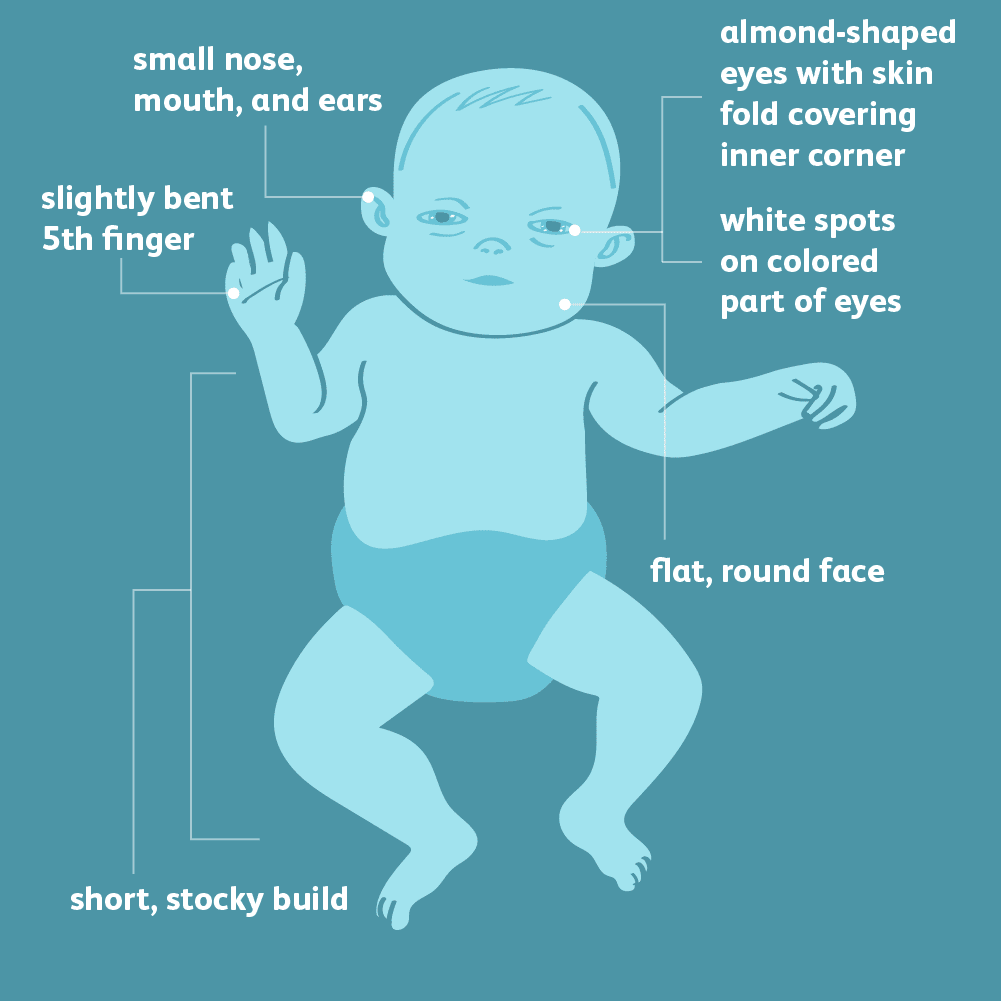
In every cell in the human body there is a nucleus, where genetic material is stored in genes. Genes carry the codes responsible for all of our inherited traits and are grouped along rod-like structures called chromosomes. Typically, the nucleus of each cell contains 23 pairs of chromosomes, half of which are inherited from each parent. Down syndrome occurs when an individual has a full or partial extra copy of chromosome 21.
This additional genetic material alters the course of development and causes the characteristics associated with Down syndrome. A few of the common physical traits of Down syndrome are low muscle tone, small stature, an upward slant to the eyes, and a single deep crease across the center of the palm – although each person with Down syndrome is a unique individual and may possess these characteristics to different degrees, or not at all.
When Was Down Syndrome Discovered?
For centuries, people with Down syndrome have been alluded to in art, literature and science. It wasn’t until the late nineteenth century, however, that John Langdon Down, an English physician, published an accurate description of a person with Down syndrome. It was this scholarly work, published in 1866, that earned Down the recognition as the “father” of the syndrome. Although other people had previously recognized the characteristics of the syndrome, it was Down who described the condition as a distinct and separate entity.
In recent history, advances in medicine and science have enabled researchers to investigate the characteristics of people with Down syndrome. In 1959, the French physician Jérôme Lejeune identified Down syndrome as a chromosomal condition. Instead of the usual 46 chromosomes present in each cell, Lejeune observed 47 in the cells of individuals with Down syndrome. It was later determined that an extra partial or whole copy of chromosome 21 results in the characteristics associated with Down syndrome. In the year 2000, an international team of scientists successfully identified and catalogued each of the approximately 329 genes on chromosome 21. This accomplishment opened the door to great advances in Down syndrome research.
Are There Different Types of Down Syndrome?
TRISOMY 21 (NONDISJUNCTION)
Down syndrome is usually caused by an error in cell division called “nondisjunction.” Nondisjunction results in an embryo with three copies of chromosome 21 instead of the usual two. Prior to or at conception, a pair of 21st chromosomes in either the sperm or the egg fails to separate. As the embryo develops, the extra chromosome is replicated in every cell of the body. This type of Down syndrome, which accounts for 95% of cases, is called trisomy 21.

MOSAICISM
Mosaicism (or mosaic Down syndrome) is diagnosed when there is a mixture of two types of cells, some containing the usual 46 chromosomes and some containing 47. Those cells with 47 chromosomes contain an extra chromosome 21.
Mosaicism is the least common form of Down syndrome and accounts for only about 1% of all cases of Down syndrome. Research has indicated that individuals with mosaic Down syndrome may have fewer characteristics of Down syndrome than those with other types of Down syndrome. However, broad generalizations are not possible due to the wide range of abilities people with Down syndrome possess.

TRANSLOCATION
In translocation, which accounts for about 4% of cases of Down syndrome, the total number of chromosomes in the cells remains 46; however, an additional full or partial copy of chromosome 21 attaches to another chromosome, usually chromosome 14. The presence of the extra full or partial chromosome 21 causes the characteristics of Down syndrome.
What Causes Down Syndrome?
Regardless of the type of Down syndrome a person may have, all people with Down syndrome have an extra, critical portion of chromosome 21 present in all or some of their cells. This additional genetic material alters the course of development and causes the characteristics associated with Down syndrome.
The cause of the extra full or partial chromosome is still unknown. Maternal age is the only factor that has been linked to an increased chance of having a baby with Down syndrome resulting from nondisjunction or mosaicism. However, due to higher birth rates in younger women, 80% of children with Down syndrome are born to women under 35 years of age.
There is no definitive scientific research that indicates that Down syndrome is caused by environmental factors or the parents’ activities before or during pregnancy.
The additional partial or full copy of the 21st chromosome which causes Down syndrome can originate from either the father or the mother. Approximately 5% of the cases have been traced to the father.
The Down Syndrome Student
While students with Down syndrome may share certain physical traits, each student is an individual and the level of general learning disability will range from mild to profound. The student with Down syndrome may have problems such as heart defects, respiratory problems and eye defects, and may variously exhibit the following characteristics: auditory and visual impairment delayed fine- and gross-motor skills, difficulties with thinking and reasoning and applying knowledge in new situations, limited concentration span, poor auditory memory, speech and language impairment and sequencing difficulties.
Generally speaking the student with Down syndrome will be better able to understand language than to communicate it expressively. Consequently cognitive skills are often underestimated. Each student with Down syndrome should be treated as an individual whose education is based on an assessment of his/her strengths and needs.
Some students with Down syndrome may have Atlanto Axial Instability (AAI), which is an abnormality in the vertebrae of the spinal column. Physical activities such as gymnastics and aquatics are particularly dangerous for those with AAI and may result in spinal damage. An X-ray is required to diagnose this condition and it is advisable that an AAI X-ray is requested in respect of students with Down syndrome who enroll
in schools.
Strategies for Learning and Teaching
- Students with Down syndrome have strong visual learning modalities. Teaching reading to students with Down syndrome should be characterised by a strong emphasis on visual learning. Visual demonstrations, pictures and illustrations can also be successfully used to assist in providing effective instruction in other subject areas of the curriculum.
- The teaching of phonics and phonological awareness should not be neglected.(Bentley et al., 2016)
- The use of manipulatives and activity learning can be beneficially employed in the development of number concepts.
- It is important that high expectations and predictability characterise all learning and teaching opportunities.
- Students with Down syndrome generally demonstrate good social skills, which can be constructively utilised to increase learning and teaching opportunities.
- Tactile demonstrations and activities also appeal to many students with Down syndrome.
- Directly teach timetables, routines and school rules to students.
- Speak directly to the student, using clear language and short sentences, and use appropriate and unambiguous facial expressions.
- Allow adequate time for the student to process language and respond.
- Structure learning and teaching opportunities to enable the student to engage in tasks with other students, who can act as appropriate role models.
- Be aware that the student may become unnecessarily dependent through the availability of excessive one-to-one support.


